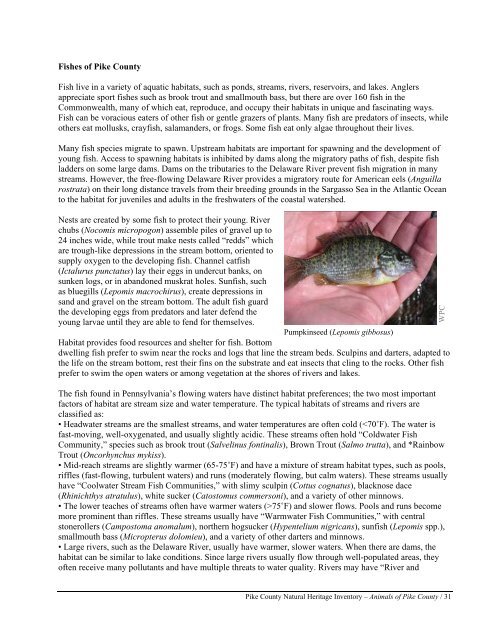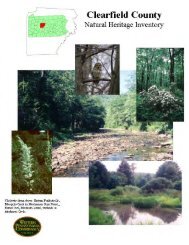Pike CNHI - Pennsylvania Natural Heritage Program
Pike CNHI - Pennsylvania Natural Heritage Program
Pike CNHI - Pennsylvania Natural Heritage Program
Create successful ePaper yourself
Turn your PDF publications into a flip-book with our unique Google optimized e-Paper software.
Fishes of <strong>Pike</strong> County<br />
Fish live in a variety of aquatic habitats, such as ponds, streams, rivers, reservoirs, and lakes. Anglers<br />
appreciate sport fishes such as brook trout and smallmouth bass, but there are over 160 fish in the<br />
Commonwealth, many of which eat, reproduce, and occupy their habitats in unique and fascinating ways.<br />
Fish can be voracious eaters of other fish or gentle grazers of plants. Many fish are predators of insects, while<br />
others eat mollusks, crayfish, salamanders, or frogs. Some fish eat only algae throughout their lives.<br />
Many fish species migrate to spawn. Upstream habitats are important for spawning and the development of<br />
young fish. Access to spawning habitats is inhibited by dams along the migratory paths of fish, despite fish<br />
ladders on some large dams. Dams on the tributaries to the Delaware River prevent fish migration in many<br />
streams. However, the free-flowing Delaware River provides a migratory route for American eels (Anguilla<br />
rostrata) on their long distance travels from their breeding grounds in the Sargasso Sea in the Atlantic Ocean<br />
to the habitat for juveniles and adults in the freshwaters of the coastal watershed.<br />
Nests are created by some fish to protect their young. River<br />
chubs (Nocomis micropogon) assemble piles of gravel up to<br />
24 inches wide, while trout make nests called “redds” which<br />
are trough-like depressions in the stream bottom, oriented to<br />
supply oxygen to the developing fish. Channel catfish<br />
(Ictalurus punctatus) lay their eggs in undercut banks, on<br />
sunken logs, or in abandoned muskrat holes. Sunfish, such<br />
as bluegills (Lepomis macrochirus), create depressions in<br />
sand and gravel on the stream bottom. The adult fish guard<br />
the developing eggs from predators and later defend the<br />
young larvae until they are able to fend for themselves.<br />
Pumpkinseed (Lepomis gibbosus)<br />
Habitat provides food resources and shelter for fish. Bottom<br />
dwelling fish prefer to swim near the rocks and logs that line the stream beds. Sculpins and darters, adapted to<br />
the life on the stream bottom, rest their fins on the substrate and eat insects that cling to the rocks. Other fish<br />
prefer to swim the open waters or among vegetation at the shores of rivers and lakes.<br />
The fish found in <strong>Pennsylvania</strong>’s flowing waters have distinct habitat preferences; the two most important<br />
factors of habitat are stream size and water temperature. The typical habitats of streams and rivers are<br />
classified as:<br />
• Headwater streams are the smallest streams, and water temperatures are often cold (75F) and slower flows. Pools and runs become<br />
more prominent than riffles. These streams usually have “Warmwater Fish Communities,” with central<br />
stonerollers (Campostoma anomalum), northern hogsucker (Hypentelium nigricans), sunfish (Lepomis spp.),<br />
smallmouth bass (Micropterus dolomieu), and a variety of other darters and minnows.<br />
• Large rivers, such as the Delaware River, usually have warmer, slower waters. When there are dams, the<br />
habitat can be similar to lake conditions. Since large rivers usually flow through well-populated areas, they<br />
often receive many pollutants and have multiple threats to water quality. Rivers may have “River and<br />
WPC<br />
<strong>Pike</strong> County <strong>Natural</strong> <strong>Heritage</strong> Inventory – Animals of <strong>Pike</strong> County / 31










